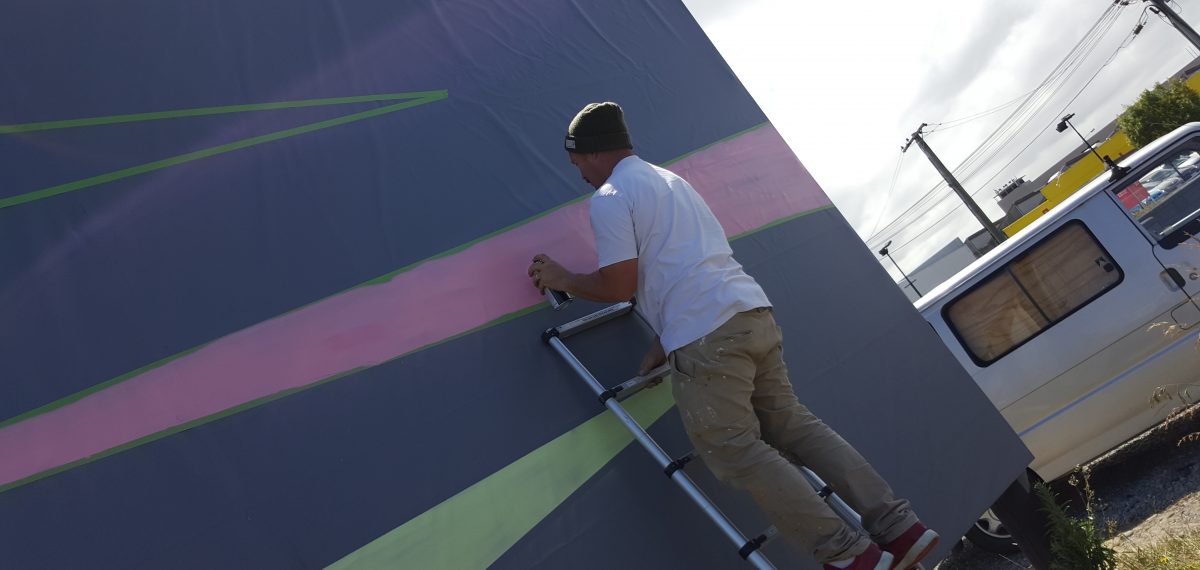A few years ago, I would have said Porta was one of Christchurch’s best kept secrets. But to make such a claim now would be misleading, his street and studio work continue to gain exposure and opportunities to work with an array of amazing talent and in a variety of contexts. Having known Porta for a good while, it is refreshing to be able to say that such reward is justifiable evidence that good things happen to good people. With his infectious energy, he constantly reminds me that getting ‘amped’ on things, as he would say, is a vital ingredient in enjoying what you do.
His array of images, heavily drawing on pop culture and his magpie-like inquisitiveness, have a strong street style, but also a sophistication that has developed with his sustained practice. Primarily a stencil artist, Porta’s work ranges from walls to found objects, such as skateboard decks, reclaimed thrift store paintings, street signs and even randomly recovered pieces of wood and metal, and even extends to large MDF cut-outs and, of course stickers. His images increasingly juxtapose pop culture references with abstract designs, distressed surfaces, or revealing indications of the aerosol medium. These playful qualities ensure his work is both accessible and attractive, easily shifting between locations, while still seeming authentic in approach. I sat down with Porta at his shared studio space Fiksate Studio and Gallery in New Brighton, and we reflected on the various projects and adventures he has experienced over the last several years, his take on his own practice and why ‘liking people’ is always a good starting block…
Although you never admit it, the last several months, actually, several years, have been pretty busy for you! Recently you assisted Dcypher and Oi YOU! with their project at the Christchurch Airport, and a few weeks prior you helped Flox with her Plymouth Lane mural in the central city. You have worked with Oi YOU! quite a bit, so there is a relationship there, but how did the opportunity to work with Flox come about? And what did you make of the experience?
I basically just put up my hand to help out where I could, if she needed it. So, I ended up buffing out big squares of colour for her and filling in some of the letters, so she could stencil over the top. I was mostly on the brush and roller…
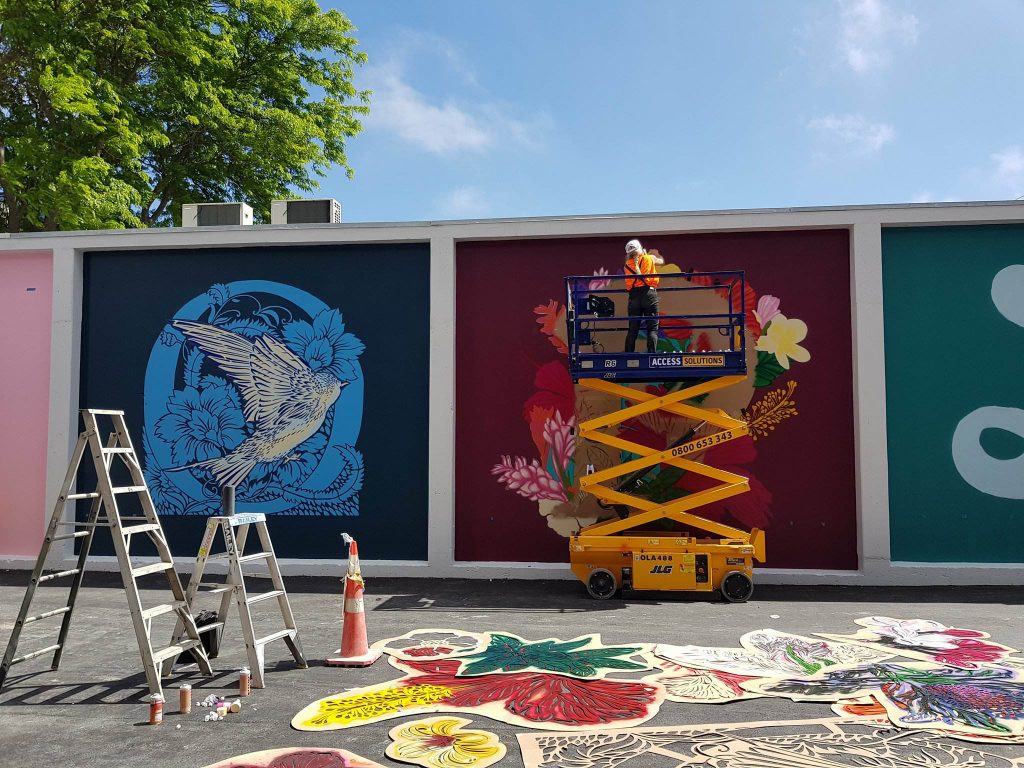
As a painter by trade, you have a practical versatility to be able to do different kinds of things and help people in different ways, and that’s given you many opportunities to work with artists on an array of projects, as well as influencing your own work. Did you always see those skills as transferrable, that they would open some doors?
Yeah, I feel like still like I’m more skilled behind a brush and roller than I am with a can, any day! (Laughs)
On the flip side, as a stencil artist, did you take the chance to step back and observe Flox’s techniques and learn from her?
I did, and she is really open when chatting about her processes, like just about the stuff she uses to cut her stencils from, and that sort of thing. She’s really open about it all, which is really cool, because sometimes, you can understand why someone might want to keep it to themselves…
I kind of feel like with stencilling there is a mystique about the process sometimes, but when you can pick up little things, you can take them in different directions. For instance, seeing such a large-scale stencil piece being produced must have been a valuable experience for you…
Yeah! The size of that work blew me away. Seeing a stencil being produced at that scale was really impressive, and seeing that it was actually do-able, it was crazy!
Speaking more broadly, not just from the ‘handy on a roller’ perspective, you have a real willingness to offer a hand wherever needed. As a result, you have worked with a wide array of people. Is that attitude just a reflection of your approach to life? Or is it that you see opportunities when they come up?
It’s important to me, I like people, so that’s a good start. From there, I really like street art and I want to see it do well in Christchurch, so it’s a combination of those two things really.
It has been a pretty amazing few years in the city, and in many ways, you’ve been right in the thick of it. Amongst a raft of well-publicised events, there has been the growth of your own ‘baby’, CAP’D, which has now been staged three times. You conceived of CAP’D a few years ago, so what was the initial idea, how has it evolved, and where do you see it going?
I asked people if they would be keen on a show of local artists who worked on the streets or were influenced by that scene. I put it to a few people, ‘what do you think if I did this…?’, and everyone I mentioned it to was just super enthusiastic and receptive to it. I had friends who wanted to be involved and put art in it. So, next thing, it really took off and it was just, ‘well, I guess I’m doing this…’ Which was a cool way to do it because it got me motivated, and the next thing I knew, I had sorted dates, found a place, and people were just so enthusiastic that there was no way I could back down!
I remember when you first started putting it together, it was originally a much smaller idea, but by the time the opening came around, it had grown into something quite different…
The support was amazing, it was meant to be this small, chilled out thing, but it ended up featuring artists from overseas, not just local artists. On the night, it was quite overwhelming, the amount of people who turned up, the amount of art that was there… Which is why for the events after that I had a wee crew of people, with Jen (Jenna-Lynn Brown), Dr Suits (Nathan Ingram) and yourself. It was definitely a team effort after that, which was a relief! (laughs)
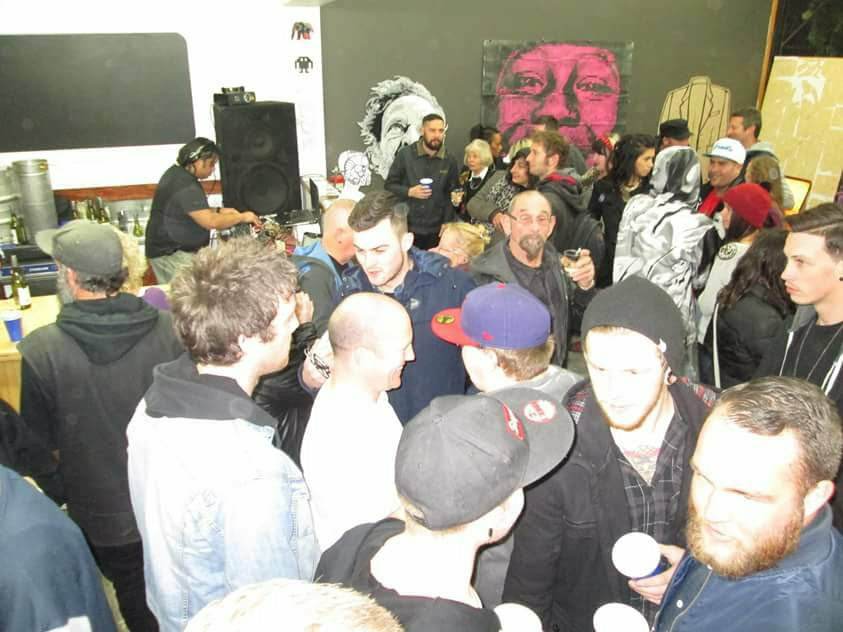
I think it showed how Christchurch has an audience that wants to see this kind of art, and these kinds of events, but also it revealed how you can connect with people from overseas, and that those networks are closer than we ever thought. Over the last several years CAP’D has featured artists from Sydney, Barcelona, Japan, Los Angeles and more, but even in the first show, there was work by artists from Melbourne and Brazil, so it kind of set the precedent…
Yeah, that just kind of happened…
It showed you can approach artists from the other side of the world and say: ‘Hey do you want to be part of something?’ and often the response is ‘Yeah!’ Were the positive responses a surprise to you?
It was, because not long before CAP’D, I’d just sort of got into Instagram, and I realised how approachable everyone was, people I considered quite well known, I didn’t expect them to respond to comments but they did, and then I thought, I’ve pushed my luck already, I should ask them if they are keen on being in an exhibition and a lot of them surprised me…
Which must be a good feeling, because that old saying ‘never meet your heroes’, isn’t always true…
Nah, sometimes it’s great to meet your heroes!
So, where do you see CAP’D going? It is now hosted at Fiksate [Design Studio and Gallery in New Brighton], and it has evolved slightly over the last few years, do you think it’s going to keep growing or are you happy for it to keep to a specific scale?
Yeah, I like the size of it. It wasn’t ever anything that was supposed to get bigger and bigger. It was supposed to be pretty small, so now it is the size that it is, and I just want to sort of keep it here, keep promoting new people, new talent, and putting them alongside talent from around New Zealand and the world…
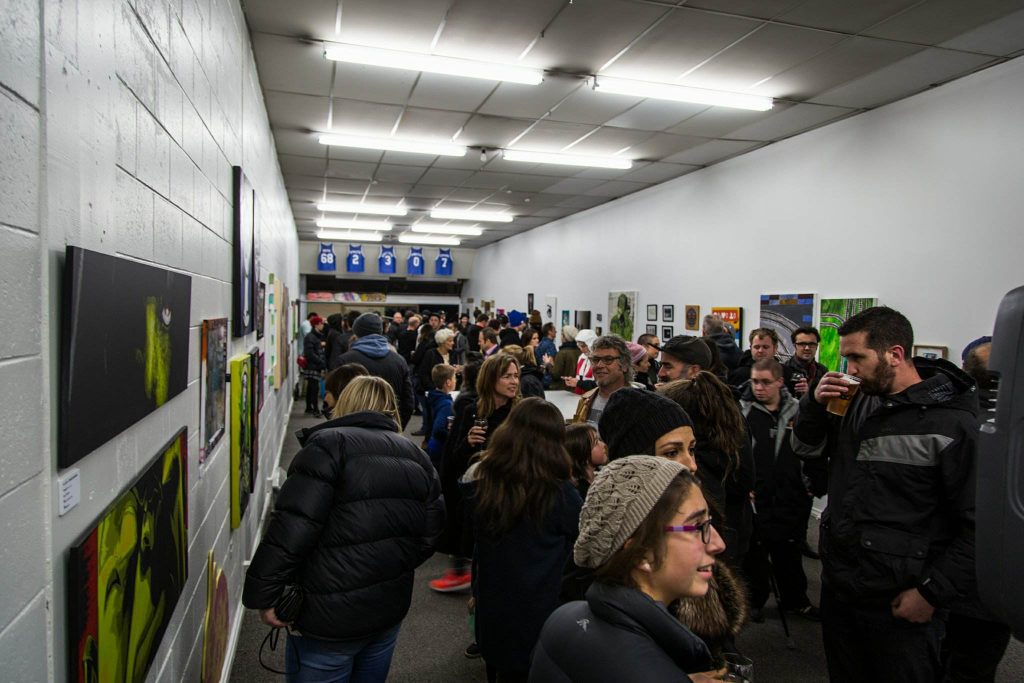
That’s the really important part, right? It’s giving a forum for young artists, lesser known artists, artists who come from particular backgrounds, where finding ways to exhibit works can be a real challenge…
Because a lot of these artists are not new artists, it’s just the first time they’ve put their art in this particular kind of environment…
Most of them have been drawing, writing, painting, making in the streets, or some of them in their bedrooms without putting anything out there, and it’s just a case of creating this new forum, so there’s real value there, and it’s partly the response of the artists that reflects that, they appreciate that you’ve created something that gives them the opportunity, so it must feel really good! (Laughs)
It does, it really does.
Talking about CAP’D’s evolution brings up another big development in your artistic life; setting up Fiksate with Dr Suits and Jen. That seems to have provided you with a real stimulus. How did it come about?
So again, I was just yarning with Nath and Jen, and saying I’d be keen on opening a spot, and then we made some connections with people who could make it happen, and all of a sudden, that momentum had picked up, and we had our spot. We did check out a couple of other places around New Brighton, but in hindsight I’m glad they didn’t work out, because our spot seems pretty perfect really…
Do you find being in that collaborative environment has expanded your practice? Does the shared, dedicated setting make it easier to explore ideas than if you were at home in the garage?
Well, I do, but sometimes I think I almost get an equal amount of satisfaction when I’ve been able to help someone get to where they want to be, rather than if I was getting myself somewhere. I think that’s why a lot of the time people want to get together with me, because they know I try to be a willing helper…
When I have been around Fiksate, there is a real feeling of coming together and problem solving, offering advice and feedback. Even when it’s not you making something yourself, that experience of thinking about somebody else’s work can be just as beneficial in the long run… Working with Jen and Nath, who both have quite diverse practices, has watching their different material approaches influenced your stencil making technique?
Yeah, (laughing), and it’s made me do things in a way I didn’t think about and to go in directions I didn’t think I would go. Like, Nath will just be buzzing on something I’m doing, and then I’ll be buzzing off something he’s doing, and then when we are all finished, whatever we have made will usually have a few similarities (laughs) and not on purpose, but we just realise we are both being so inspired by what is happening in the studio that it comes out in our work… Like with the piece I did for Blind Date, which was an exhibition for First Thursdays last year, and probably the series of Donald Duck works that came from that, I think they came together in that way, even though the piece was a colab with another artist, Kara Burrows, we kind of worked separately, and it was at the studio that my part really came together. I feel like Nath had a bunch to do with that, and you were there that night too… I was trying something new and you guys were getting really hyped off the stuff I was doing, and I think that excitement came out in the work, so yeah, I think that is what it’s all about, just getting each other really hyped on the new stuff you’re doing and then you want to do heaps of it and take it further…
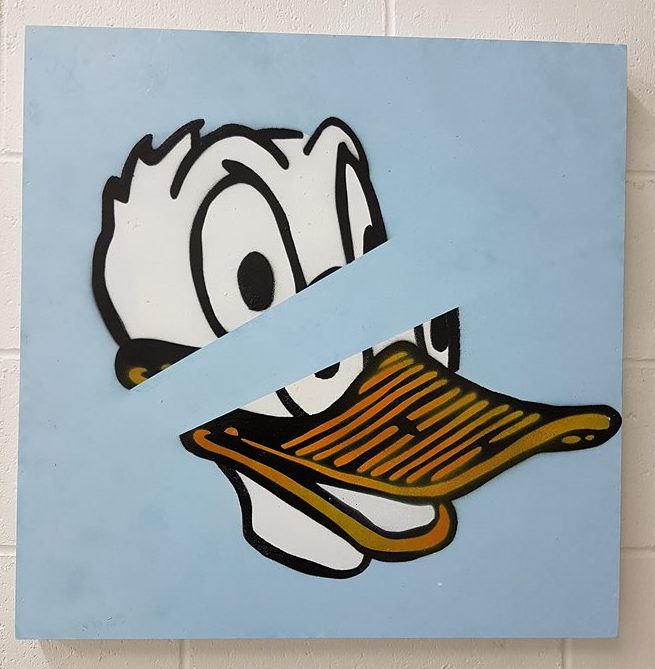
Tell me about the development of your stencil style over time, because, to me, your stencils, despite their diverse nature, from the actual images to the material surfaces you use, they always seem to reflect a street vibe, how did you get started?
I think I had been influenced by a stencil I saw in town, on Manchester Street years ago, like in the mid to late nineties, so I tried to make a stencil, I was listening to a bunch of Foo Fighters, and I tried to make a Dave Grohl stencil and I ended up with a bunch of shredded cardboard that didn’t stay together and I just hiffed it away! Then I sort of revisited it, it must have been four of five years later…
It seems like everyone’s first attempt is always some pop culture icon, a musician or an actor… Do you think it has something to do with the medium? Does the technique encourage you to try and produce something realistic, and then we are just drawn in by pop culture through the image saturation of celebrities? Maybe it’s just the association of that type of imagery with street art’s vocabulary and traditions, that immediately recognisable image to grab someone’s attention…
That’s funny when I think about it, I don’t know why that would be, but it does seem true, they are probably the things that are making an impact on your life at the time. Thinking about those early stencils, I used to make stencils from the outside cover of an exercise book from school, and you just sort of made do. I think I had a huckery old craft knife. I think the drawing I did of Dave Grohl, I was pretty amped on it, and then I just tried to make it into a stencil and I couldn’t quite pull it together!
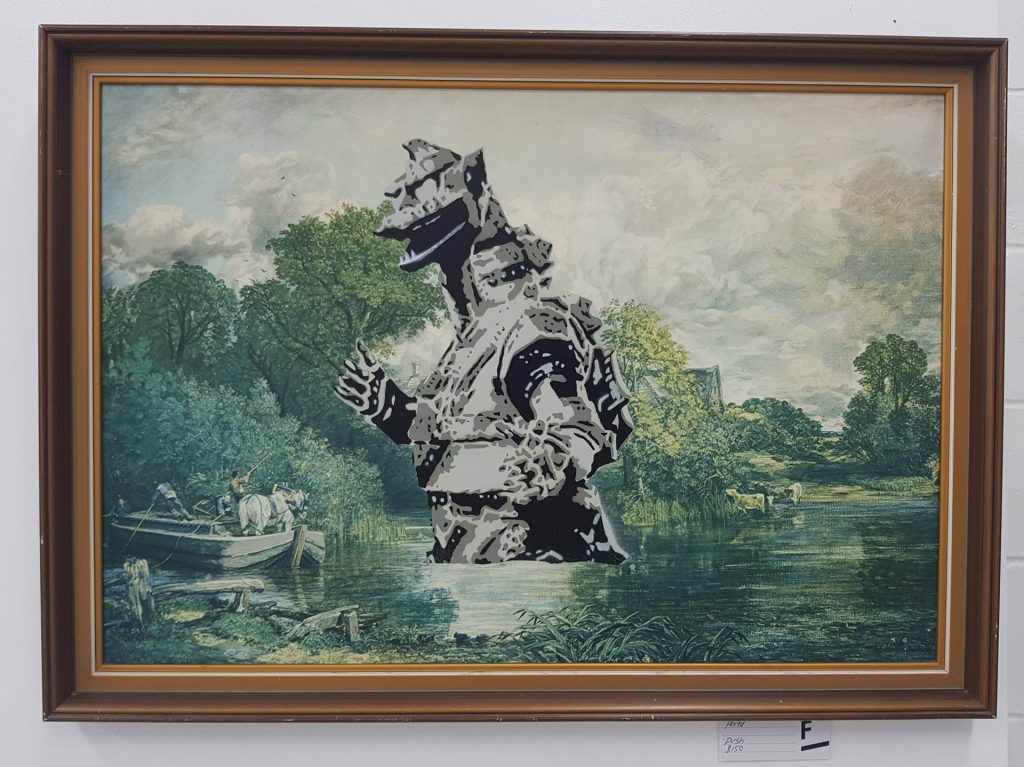
It’s a technique where there is value in just trying and failing, and then starting again. I think there is also a lack of pretense as well, I mean using the cover of an exercise book, using a cereal box, like that approach is entirely fitting, and even now, you’ll know, you have a preferred method to use to cut stencils, but it varies wildly, different people use different things and it’s all about the way they’ve developed their techniques. So, then you picked it back up after murdering Dave…
Maybe four years ago? Maybe more, I can’t pin-point it. I know the next one I did was based on a sketch of R2D2 [the droid from Star Wars] that I’d done, it’s on the rubbish bin at home, that’s the only place it ever went, but I think from there I started messing round with the technique more and more…

Who were your influences? Who, or what made you think, ‘Yeah, stencils are for me…’?
Of course, Banksy would have been an influence and I think he’s great. I liked that he was doing things I didn’t expect. I mean everyone likes to be surprised, and when I saw what he was doing, it made me want to try different things. But there were other people too. I like a Mexican artist called Acamonchi. I like his punk style, I was never into punk so much, but his style and that aesthetic just appealed to me, it was gritty and dirty and cheeky, the images were sort of taking a whole heap of ideas and layering them up in a messy way, just making really interesting mash-ups that came together super well, in a really free sort of way.
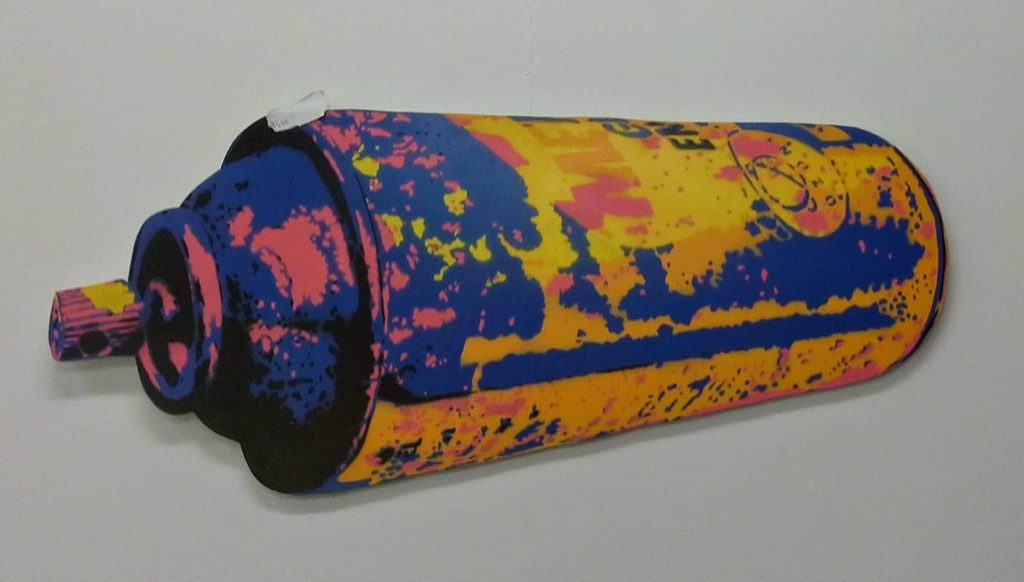
Even though graffiti is so strongly entwined with hip hop, for the wider street art culture, or post-graffiti, and I guess some graffiti writers, punk is a really significant influence, in visual style, material forms, like the influence of band fliers and posters, and of course the anarchic, DIY attitude…
Yeah, there is definitely a strong punk influence in the history of stencilling, it’s an unavoidable influence.
Did you primarily see stencilling as a street technique, or did you also perceive it as something that could transfer from wall to canvas, so to speak?
When I started I just wanted it to be on the street, I didn’t ever want to stencil on something you could keep. But then over time, I started appreciating the time you could spend on a stencil, that you could layer them up. Then I started wanting them to, you know, stick around a bit longer, and just look at them and see what I was going to do with my next one, stuff like that…
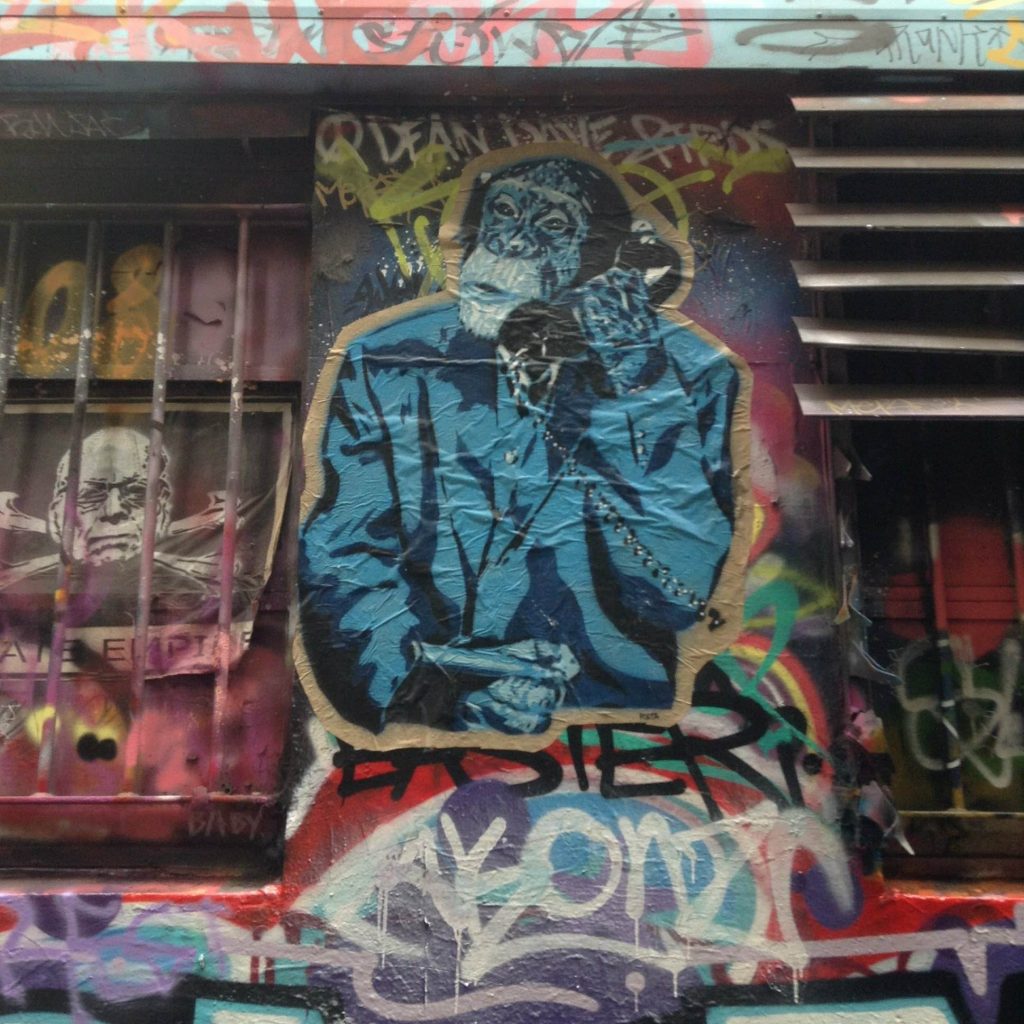
Now you work on a whole range of different surfaces and objects, but in many ways, they retain a sense of street work, at least in their visual style. While stencils are your primary method, your other love is stickers and slaps…
Yeah, definitely!
You have made thousands of stickers; hand-drawn, stencilled, you have even used block printing techniques, when did you start to making stickers? Did that come after starting to cut stencils?
That would’ve come before. I was always trying to draw stuff and I think one of the guys who influenced the sticker side of things for me was definitely [Christchurch artist] Xpres. He’s always been a real sticker guy, he’s always collected them, always made them, always putting them up around the streets, always with really nice hand styles. Eventually I found out the sticker culture was big in America. I was on the internet all the time trying to find out more, and I discovered a magazine called Peel Magazine, that I couldn’t actually get in New Zealand, but I could find stuff about it online, and so I just got real obsessed with that for a bit. I also came across a guy called Chris RWK, doing these designs called Robots Will Kill, and I just thought what he was doing was so cool, and the more I looked into it, the more I liked it. I think stickers, even though I do stencils, stickers will always be my favourite…
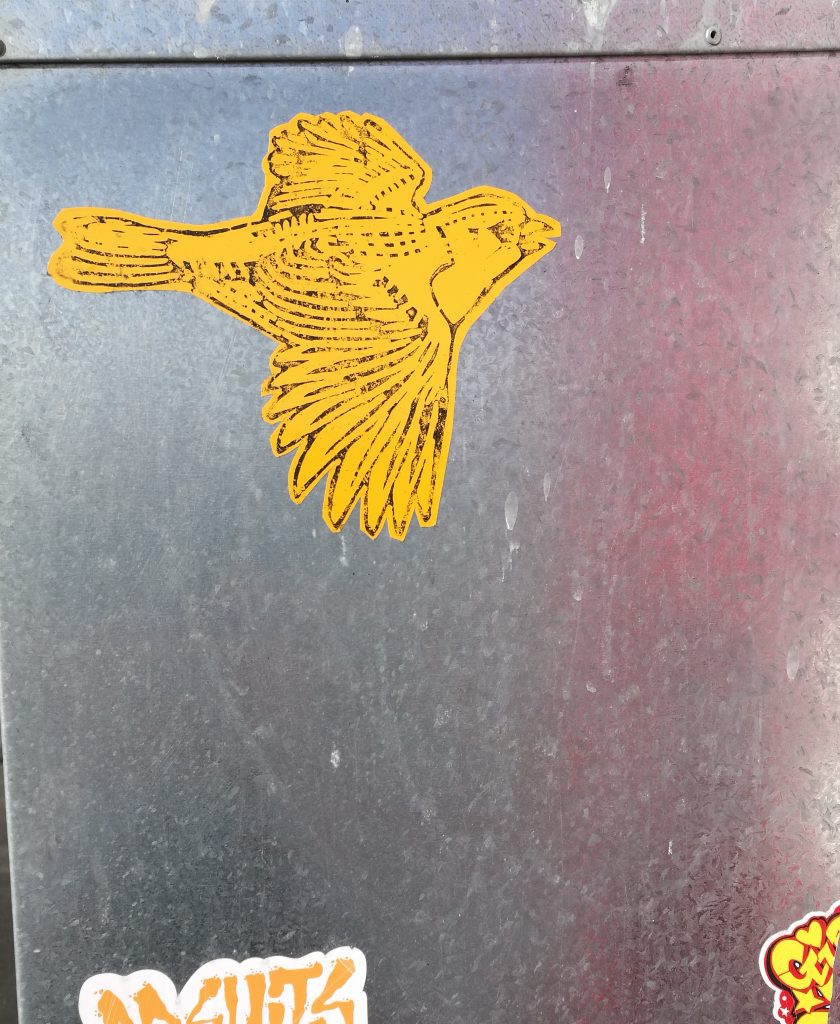
Speaking of stickers and Xpres, we were lucky enough to be involved with the ‘Stick ‘Em Up’ room for the first Spectrum show at the YMCA in 2014, and I remember how deep you got into the concept there, which was built on the idea of social media networks and dissemination, which was how we collected so many stickers from all over the world. You were just hounding people for stickers! What are your memories of that whole experience?
Again, I think it was before Facebook and Instagram worked the way they do now, because they play with the algorithms and stuff, but at the time, when people put stuff up, you saw it right away, and so we were messaging all these sticker artists we stumbled across, I was getting in touch with them, telling them about this event and trying to get them interested by name dropping people who were going to be in the show. And so many people, like eight out of ten people, were keen to be in it and then two would be like: ‘This some sort of scam and you just want to get some free art off me!’ (Laughs) Which I understand!
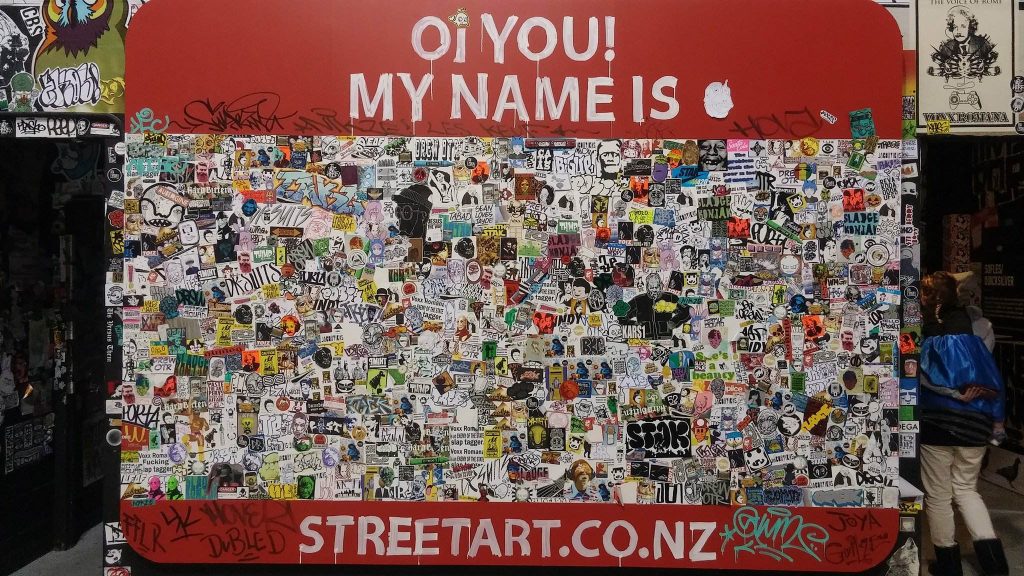
Yeah, it is understandable because of the nature of social media interaction, but it also shows that if don’t ask, you’ll never know…
Exactly, I remember, I had this book and I had written down, I think there was close to 800 people that I had contacted! Some people didn’t get back to me, but I remember thinking: ‘Man, it would be a crack up if on the day we are able to start the room, we had a big sack of stickers’, and I didn’t see it happening, but that was exactly what happened, like exactly! With that project, the other thing that sticks out was the whole team thing as well. It was Xpres, Nathan, Jen, yourself, and me, and I think it was such a cool team and we were all getting amped, everyday when something new turned up in the post we were just so excited, I’ve never been so amped!
For me, the temporary nature of that project was really cool, the fact that it is no longer there, that you can’t go and see it anymore, it’s an experience that was so ephemeral, and yet completely consumed our little team for so long, and we were so involved in the evolution of that space…
It’s like, was it even real? (Laughs) I walked around the room and made a video and I sometimes have a look at that. It was pretty cool…
You have been exhibiting more and more over the last few years, with CAP’D, at Fiksate, First Thursdays, and recently in some shows at the Welder Collective, are you more comfortable about making work to exhibit, or is it still something you are coming to terms with?
I don’t know if I’ll ever be super comfortable with it, but yeah, I’m more comfortable with it than I was at the start. But I’m a chronic procrastinator as well, so I’m always doing stuff down to the line and luckily a lot of the people I’m working with know me well and are quite patient (laughs), which I appreciate, because I know I always cut it fine! I don’t know why, it’s like if there’s no urgency, there’s no priority. But, I did always say, right from the start, if I ever felt like I was being pressured with this stuff and it wasn’t fun, I would stop. I do wonder if I get a buzz off doing stuff at the last minute…
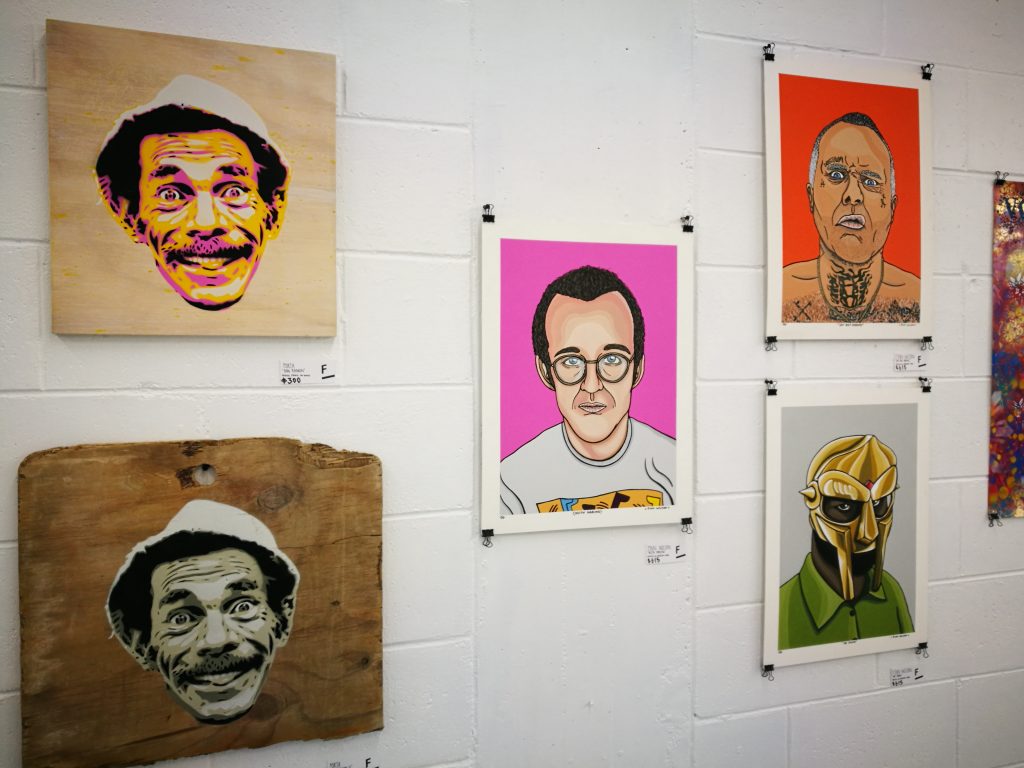
You need the adrenaline?
That could be it, I don’t know, I’m just sort of thinking that i always seems to end up that way!
As well as exhibiting more often, and helping other artists, you have been doing some of your own public work, probably the most noticeable larger public piece you did was the First Thursdays billboard on Colombo Street in 2016. Do you want to do more outdoor legal commissions, or you would rather make smaller stencils and make stickers?
I think that smaller stuff is really my style, but after working with Flox and seeing how she made that larger scale stuff look really fun, I think it would be cool to revisit it. That panel I did for First Thursdays was a bit of a nightmare, it was a bit of learning curve. The stuff I made my stencil out of was too light, and as I went to hang it up the wind came up. I was so stressed out, I didn’t enjoy it so much. I was so relieved when it was all over, which has made me not really want to do that size again, but then again, working with Flox, she made it look like something that can be quite manageable, and that makes it attractive again.
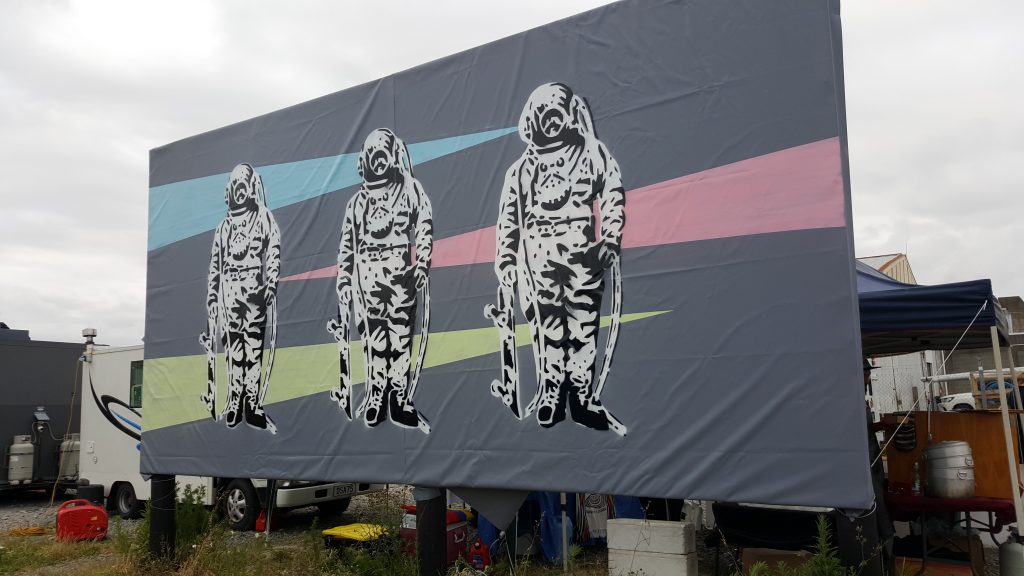
Making large scale stencils does bring a whole heap of challenges, especially when working in a public space. I guess often it comes down to compartmentalising the process, and that relates back to the stencil process itself: when you make a stencil, you cut layers and build those layers, so in making a larger scale work, it’s sort of the same principle, in that if you make those layers manageable, and build it piece by piece, you can take away some of the problems…
The other person who is great to work with and watch as far as doing large scale stuff, is Joel Hart, just seeing how, I don’t want to say he cuts corners, but I’ll feel like there is a way to do it and he’ll go: ‘Nah, there’s an easier way’, and he’ll just think outside the box and think of something different, and it’s amazing, it’s so cool to watch.
Speaking of local artists, who are you excited about? Who do you always keep an eye out for in the streets?
I am really interested to see what Kill is going to do next. I enjoy him because I never can predict what he is going to do. I sort of feel like maybe he is drifting towards doing more music, but that dude never fails to surprise you, which is great. I remember the first time I ever met Joel Hart, looking back, I was doing a market with these budget as, horrible stencils and he wandered up and his little girl was with him and we just got talking and he said he liked stencils, he didn’t say anything else and I was like would your girl like one of these, and I just gave it to her, and now I wish I had given him a better one! (Laughs) But from there, he took off with his stencils and got all famous and stuff! (Laughs) But it’s funny how things work out. I love seeing his stuff, I get amped seeing his work…
A few months ago, you helped Dr Suits with his piece for the Carnaby Lane event in New Brighton, which Joel was also part of, it looked like a fun day…
It was great! That was so much fun. I had so much fun with that. It was originally supposed to be a collaboration, but just the way things went, we ended up working with one of Nathan’s designs. So, I ended up helping him more than putting my own design up, but I just had an absolute ball. I’ve never been so relaxed working on a big piece, working outside. Nath’s just so chill about everything, and the sponsor was flicking us beers, so we were pretty happy!
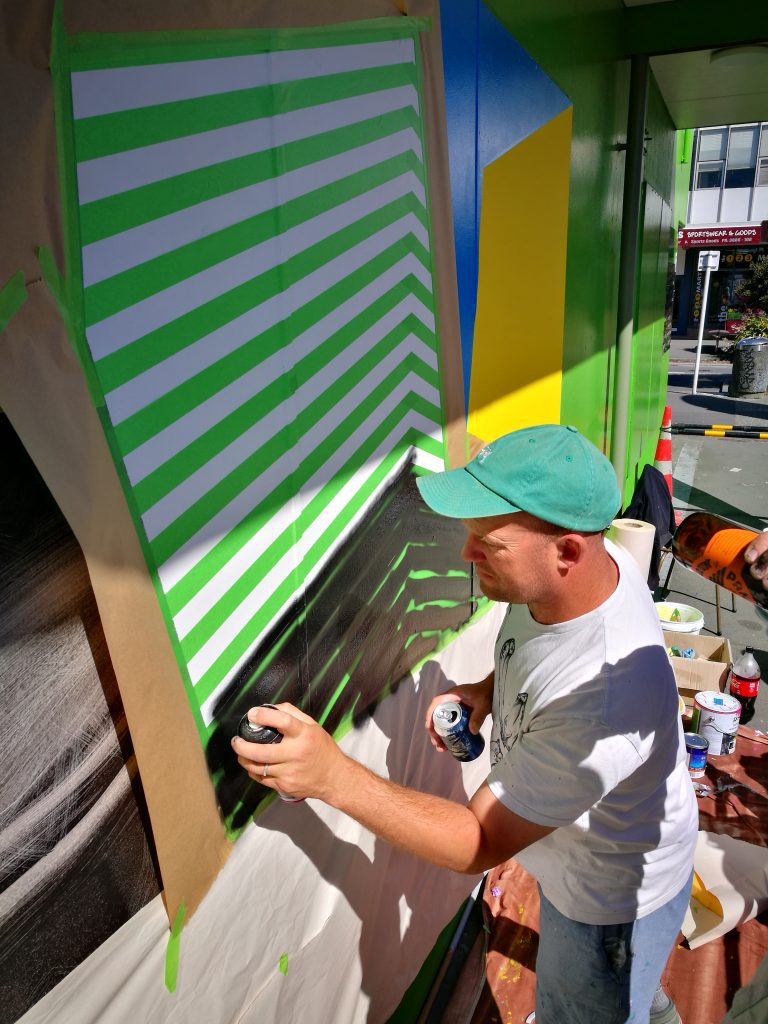
In a way, that brings us full circle to where we started: you got to use your painting skills, cutting in, masking off, to help someone out…
Yeah, I’m stoked when those skills are useful, I think that’s where my talents maybe really lie!
I think everybody knows you’re a man of many talents! So, what is coming up in the next few months?
I am going to be part of Stoked, which is an exhibition of surf-inspired art as part of the Duke Festival in New Brighton, and then we have a Fiksate show, Visitors, at The Welder on the 16th March, which should be good times, New Brighton comes to the city! Come and check it out!
Cheers Porta!
Visitors opens at The Welder on Welles Street on Friday, March 16, at 5:30pm. Alongside Porta, Visitors also features work by Jen, Dr Suits, Bols and MFC Lowt.
Follow Porta on Instagram

